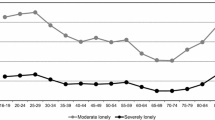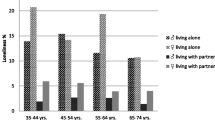Abstract
Purpose
Loneliness is a recognised public-health concern that is traditionally regarded as a unidimensional construct. Theories of loneliness predict the existence of subtypes of loneliness. In this study, latent class analysis (LCA) was used to test for the presence of loneliness subtypes and to examine their association with multiple mental health variables.
Methods
A nationally representative sample of US adults (N = 1839) completed the De Jong Gierveld Loneliness Scale, along with self-report measures of childhood and adulthood trauma, psychological wellbeing, major depression, and generalized anxiety.
Results
When treated as a unidimensional construct, 17.1% of US adults aged 18–70 were classified as lonely. However, the LCA results identified four loneliness classes which varied quantitatively and qualitatively: ‘low’ (52.8%), ‘social’ (8.2%), ‘emotional’ (26.6%), and ‘social and emotional’ (12.4%) loneliness. The ‘social and emotional’ class were characterised by the highest levels of psychological distress, followed by the ‘emotional’ class. The ‘social’ loneliness class had similar mental health scores as the ‘low’ loneliness class. Childhood and adulthood trauma were independently related to the most distressed loneliness classes.
Conclusions
Current findings provide support for the presence of subtypes of loneliness and show that they have unique associations with mental health status. Recognition of these subtypes of loneliness revealed that the number of US adults aged 18–70 experiencing loneliness was twice as high as what was estimated when loneliness was conceptualized as a unidimensional construct. The perceived quality, not the quantity, of interpersonal connections was associated with poor mental health.

Similar content being viewed by others
References
Hunter D (2012) Loneliness: a public health issue. Perspect Public Health 132:153–153. https://doi.org/10.1177/1757913912449564
Cacioppo JT, Hawkley L, Thisted RA (2010) Perceived social isolation makes me sad: 5-year cross-lagged analyses of loneliness and depressive symptomatology in the Chicago health, aging, and social relations study. Psychol Aging 25:453–463. https://doi.org/10.1037/a0017216
Caspi A, Harrington H, Moffitt TE, Milne BJ, Poulton R (2006) Socially isolated children 20 years later: risk of cardiovascular disease. Arch Pediatr Adolesc Med 160:805–811. https://doi.org/10.1001/archpedi.160.8.805
Stickley A, Koyanagi A, Roberts B, Richardson E, Abbott P, Tumanov S, McKee M (2013) Loneliness: its correlates and association with health behaviours and outcomes in nine countries of the former Soviet Union. PLoS One 8:e67978. https://doi.org/10.1371/journal.pone.0067978
Lasgaard M, Friis K, Shevlin M (2016) “Where are all the lonely people?” A population-based study of high-risk groups across the life span. Soc Psychiatry Psychiatr Epidemiol 51:1373–1384. https://doi.org/10.1007/s00127-016-1279-3
Stravynski A, Boyer R (2001) Loneliness in relation to suicide ideation and parasuicide: a population-wide study. Suicide Life Threat Behav 31:32–40
Anderson OG (2010) Loneliness among older adults: a national survey of adults 45+. AARP Research, Washington, DC. https://doi.org/10.26419/res.00064.001
Sønderby LC, Wagoner B (2013) Loneliness: an integrative approach. J Integr Soc Sci 3:1–29
Weiss RS (1974) The provisions of social relationships. In: Rubin Z (ed) Doing unto others: Joining, molding, conforming, helping, loving. Prentice-Hall, Englewood Cliffs, pp 17–26
Gierveld JDJ, Van Tilburg T (2010) The De Jong Gierveld short scales for emotional and social loneliness: tested on data from 7 countries in the UN generations and gender surveys. Eur J Ageing 7:121–130. https://doi.org/10.1007/s10433-010-0144-6
Liu BS, Rook KS (2013) Emotional and social loneliness in later life: associations with positive versus negative social exchanges. J Soc Pers Relatsh 30:813–832. https://doi.org/10.1177/0265407512471809
Dahlberg L, McKee KJ (2014) Correlates of social and emotional loneliness in older people: evidence from an English community study. Aging Ment Health 18:504–514. https://doi.org/10.1080/13607863.2013.856863
Dykstra PA, Fokkema T (2007) Social and emotional loneliness among divorced and married men and women: comparing the deficit and cognitive perspectives. Basic Appl Soc Psych 29:1–12. https://doi.org/10.1080/01973530701330843
van der Velden PG, Pijnappel B, van der Meulen E (2017) Potentially traumatic events have negative and positive effects on loneliness, depending on PTSD-symptom levels: evidence from a population-based prospective comparative study. Soc Psychiatry Psychiatr Epidemiol 53:1–12. https://doi.org/10.1007/s00127-017-1476-8
Cohen-Mansfield J, Shmotkin D, Goldberg S (2009) Loneliness in old age: longitudinal changes and their determinants in an Israeli sample. Int Psychogeriatr 21:1160–1170. https://doi.org/10.1017/S1041610209990974
Gibson RL, Hartshorne TS (1996) Childhood sexual abuse and adult loneliness and network orientation. Child Abuse Negl 20:1087–1093
Merz EM, Jak S (2013) The long reach of childhood. Childhood experiences influence close relationships and loneliness across life. Adv Life Course Res 18:212–222. https://doi.org/10.1016/j.alcr.2013.05.002
Stein JY, Itzhaky L, Levi-Belz Y, Solomon Z (2017) Traumatization, loneliness, and suicidal ideation among Ex-POWs: a longitudinally assessed sequential mediation model. Front Psychiatry 8:281. https://doi.org/10.3389/fpsyt.2017.00281
Shevlin M, McElroy E, Murphy J (2015) Loneliness mediates the relationship between childhood trauma and adult psychopathology: evidence from the adult psychiatric morbidity survey. Soc Psychiatry Psychiatr Epidemiol 50:591–601. https://doi.org/10.1007/s00127-014-0951-8
DiTommaso E, Spinner B (1997) Social and emotional loneliness: a re-examination of Weiss’ typology of loneliness. Pers Individ Differ 22:417–427. https://doi.org/10.1016/S0191-8869(96)00204-8
Russell D, Cutrona CE, Rose J, Yurko K (1984) Social and emotional loneliness: an examination of Weiss’s typology of loneliness. J Pers Soc Psychol 46:1313–1321
Peerenboom L, Collard RM, Naarding P, Comijs HC (2015) The association between depression and emotional and social loneliness in older persons and the influence of social support, cognitive functioning and personality: a cross-sectional study. J Affect Disord 182:26–31. https://doi.org/10.1016/j.jad.2015.04.033
Schnittger RI, Wherton J, Prendergast D, Lawlor BA (2012) Risk factors and mediating pathways of loneliness and social support in community-dwelling older adults. Aging Ment Health 16:335–346. https://doi.org/10.1080/13607863.2011.629092
Drageset J, Espehaug B, Kirkevold M (2012) The impact of depression and sense of coherence on emotional and social loneliness among nursing home residents without cognitive impairment—a questionnaire survey. J Clin Nurs 21:965–974. https://doi.org/10.1111/j.1365-2702.2011.03932.x
Shevlin M, Murphy S, Murphy J (2014) Adolescent loneliness and psychiatric morbidity in the general population: identifying “at risk” groups using latent class analysis. Nord J Psychiatry 68:633–639. https://doi.org/10.3109/08039488.2014.907342
Russell DW (1996) UCLA loneliness scale (version 3): reliability, validity, and factor structure. J Pers Assess 66:20–40. https://doi.org/10.1207/s15327752jpa6601_2
de Jong Gierveld J, van Tilburg TG (2006) A 6-item scale for overall, emotional, and social loneliness: confirmatory tests on survey data. Res Aging 28:582–598. https://doi.org/10.1177/0164027506289723
De Jong Gierveld J, Van Tilburg T (2010) The De Jong Gierveld short scales for emotional and social loneliness: tested on data from 7 countries in the UN generations and gender surveys. Eur J Ageing 7:121–130. https://doi.org/10.1007/s10433-010-0144-6
Shevlin M, Murphy S, Mallet J, Stringer M, Murphy J (2013) Adolescent loneliness and psychiatric morbidity in Northern Ireland. Br J Clin Psychology 52:230–234. https://doi.org/10.1111/bjc.12018
Weathers FW, Blake DD, Schnurr PP, Kaloupek DG, Marx BP, Keane TM (2013) The life events checklist for DSM-5 (LEC-5). Instrument available from the National Center for PTSD at http://www.ptsd.va.gov. Accessed 25 June 2017
Felitti VJ, Anda RF, Nordenberg D, Williamson DF, Spitz AM, Edwards V, et al. (1998) Relationship of childhood abuse and household dysfunction to many of the leading causes of death in adults. The Adverse childhood experiences (ACE) study. Am J Prev Med 14:245–258
World Health Organization: Regional Office for Europe (1998) Wellbeing measures in primary health care: the DepCare project. In: Consensus meeting, Stockholm
Topp CW, Østergaard SD, Søndergaard S, Bech P (2015) The WHO-5 well-being index: a systematic review of the literature. Psychother Psychosom 84:167–176. https://doi.org/10.1159/000376585
Awata S, Bech P, Koizumi Y, Seki T, Kuriyama S, Hozawa A, et al. (2007) Validity and utility of the Japanese version of the WHO-five well-being index in the context of detecting suicidal ideation in elderly community residents. Int Psychogeriatr 19:77–88. https://doi.org/10.1017/S1041610206004212
Kroenke K, Strine TW, Spitzer RL, Williams JB, Berry JT, Mokdad AH (2009) The PHQ-8 as a measure of current depression in the general population. J Affect Disord 114:163–173. https://doi.org/10.1016/j.jad.2008.06.026
Spitzer RL, Kroenke K, Williams JB, Lowe B (2006) A brief measure for assessing generalized anxiety disorder: the GAD-7. Arch Intern Med 166:1092–1097. https://doi.org/10.1001/archinte.166.10.1092
Manea L, Gilbody S, McMillan D (2015) A diagnostic meta-analysis of the Patient Health Questionnaire-9 (PHQ-9) algorithm scoring method as a screen for depression. Gen Hosp Psychiatry 37:67–75. https://doi.org/10.1016/j.genhosppsych.2014.09.009
Kertz S, Bigda-Peyton J, Bjorgvinsson T (2013) Validity of the generalized anxiety disorder-7 scale in an acute psychiatric sample. Clin Psychol Psychother 20:456–464. https://doi.org/10.1002/cpp.1802
Muthén LK, Muthén BO (2013) Mplus user’s guide, 7th edn. Muthén & Muthén, Los Angeles
Yuan KH, Bentler PM (2000) Three likelihood-based methods for mean and covariance structure analysis with nonnormal missing data. Sociol Methodol 30:165–200. https://doi.org/10.1111/0081-1750.00078
Akaike H (1987) Factor analysis and the AIC. Psychometrika 52:317–332
Schwartz G (1978) Estimating the dimension of a model. Ann Stat 6:461–464
Sclove SL (1987) Application of model-selection criteria to some problems in multivariate analysis. Psychometrika 52:333–343
Lo Y, Mendell N, Rubin DB (2001) Testing the number of components in a normal mixture. Biometrika 88:767–778
Nylund KL, Asparouhov T, Muthén B (2007) Deciding on the number of classes in latent class analysis and growth mixture modeling. A Monte Carlo simulation study. Struct Equ Model 14:535–569. https://doi.org/10.1080/10705510701575396
Bakk Z, Vermunt JK (2016) Robustness of stepwise latent class modeling with continuous distal outcomes. Struct Equ Model 23:20–31. https://doi.org/10.1080/10705511.2014.955104
Bakk Z, Tekle FB, Vermunt JK (2013) Estimating the association between latent class membership and external variables using bias adjusted three-step approaches. In: Liao TF (ed) Sociological methodology. SAGE Publications, Thousand Oaks
Vermunt J (2010) Latent class modeling with covariates: two improved three-step approaches. Political Anal 18:450–469
Asparouhov T, Muthén B (2014) Auxiliary variables in mixture modelling: using the BCH method in Mplus to estimate a distal outcome model and an arbitrary secondary model. Stat Model. https://www.statmodel.com/download/asparouhov_muthen_2014.pdf. Accessed 25 June 2017
Pearce J, Simpson J, Berry K, Bucci S, Moskowitz A, Varese F (2017) Attachment and dissociation as mediators of the link between childhood trauma and psychotic experiences. Clin Psychol Psychother 24:1304–1312. https://doi.org/10.1002/cpp.2100
Walsh K, Fortier MA, DiLillo D (2010) Adult coping with childhood sexual abuse: a theoretical and empirical review. Aggress Violent Behav 15:1–13. https://doi.org/10.1016/j.avb.2009.06.009
Funding
This work was supported by the National Institutes of Mental Health (Grant number R01 MH08661).
Author information
Authors and Affiliations
Contributions
PH, MS, MC, and JMP developed the study concept. PH, MS, GM, and RF conducted the statistical analyses. JMP wrote the introduction. TK, FV, and MC contributed to the writing of the discussion. All authors reviewed, revised, and contributed to the writing of the final version of the manuscript. All authors have approved the final version of the paper for submission.
Corresponding author
Ethics declarations
Conflict of interest
On behalf of all authors, the corresponding author states that there is no conflict of interest.
Rights and permissions
About this article
Cite this article
Hyland, P., Shevlin, M., Cloitre, M. et al. Quality not quantity: loneliness subtypes, psychological trauma, and mental health in the US adult population. Soc Psychiatry Psychiatr Epidemiol 54, 1089–1099 (2019). https://doi.org/10.1007/s00127-018-1597-8
Received:
Accepted:
Published:
Issue Date:
DOI: https://doi.org/10.1007/s00127-018-1597-8




